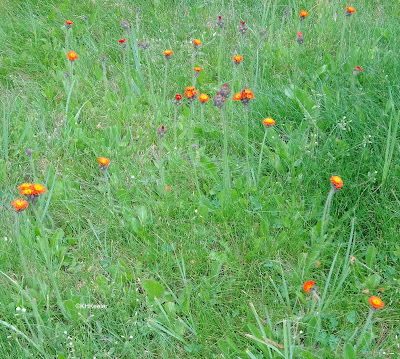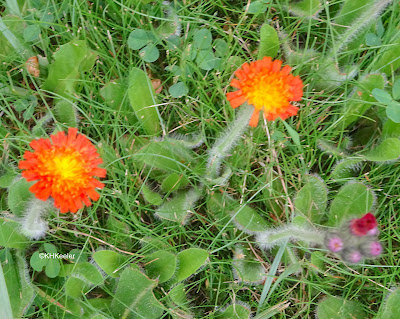I grew up calling it Indian paintbrush, so when I went west and was shown Indian paintbrush, I was puzzled. Currently, the websites say hawkweed is Hieracium, and Indian paintbrush is Castilleja. No relation between them. So I've learned to call the plant hawkweed. Actually, orange hawkweed, Hieracium aurantiacum or Pilosella aurantiaca.
 |
| orange hawkweed, Hieracium aurantiacum |
Hawkweeds are plants in the sunflower family, Asteraceae, rather closely related to dandelions and chichory. The genus Hieracium contains some 800 species that are well-described and recognized by experts. Another thousand or more races and variants have been observed; these might be additional species. Botanists have tried to reduce the complexity of the genus Hieracium by raising subgroups to be separate genera. If you take that route, the orange hawkweed I am writing about becomes Pilosella aurantiaca. None of the major North American sources I consulted--USDA Plants database, Flora of North America, U.S. Forest Service (see References)--accepted Pilosella. As a result, finding information on the plant is easy as Hieracium aurantiacum and difficult as Pilosella aurantiaca. (That is less true outside the U.S.; there check Pilosella as well as Hieracium). I will call it Hieracium and await new studies of this very complicated group of plants.
Hieraciums are native all over the world. For North America, the USDA Plants database lists 30 native Hieracium species, 10 introduced species, and 9 distinctive hybrids.
 |
| orange hawkweed, Hieracium aurantiacum |
Hawkweeds are hard to divide into species because their reproduction is so complicated. Like dandelions, many or most hawkweeds are apomictic; the seed forms without sexual reproduction, making it a clone of the parent. It is difficult to determine what a species is for apomictic plants. The rule we would like to use, "crosses and produces viable offspring" to recognize members of the same species, just doesn't work for apomicts. In addition, many hawkweeds, particularly orange hawkweed and its close relatives, reproduce by stolons (like chichory). So a big display of orange hawkweed might well all have exactly the same genes, through runners, not apomixis. Finally, orange hawkweed, and others, will sometimes cross, making normal seeds with two genetic parents. From no genetic variation to ordinary variation, hawkweeds are tough to subdivide and many botanists do not try.
Orange hawkweed is native to Europe and currently found all across the world. It was intentionally brought to North America in 1875 for its pretty blossoms. The horticultural trade spread "this favourite old cottage garden plant" and then it naturalized. It does not seem to be available for sale in the North America at present.
 |
| orange hawkweed, Hieracium aurantiacum |
Orange hawkweed is now widespread in northern North America, growing well on roadsides, in moist pastures, forest gaps, and abandonded fields, and many other places. It easily becomes too abundant. It is listed as a noxious weed in Alaska, and Colorado. Minnesota found it seriously invasive but decided not to list it as a noxious weed because it is too widespread--! (link). Most other species of hawkweed are also considered very invasive outside their native ranges. Meanwhile, I believe orange hawkweed is protected (rare) in some of its native range, the mountains of Europe, but I could find no specifics.
The name hawkweed goes back before to Pliny the Elder (died 79 CE), who, in his Natural History wrote "known to some persons as "hieracion;" from the circumstance that the hawk tears it open and sprinkles its eyes with the juice, and so dispels any dimness of sight of which it is apprehensive." (Book 20, Chapter 26 link ) (Hierax is Greek for hawk. Pliny's "hawk-weed" was a large group of plants in the sunflower family with milky sap, including the ones we currently call hawkweeds.)
 |
| hawkweed, open flowers and clusters of buds |
While European sources often list Hieracium aurantiacum (aurantiacum means orange) as orange hawkweed, it is also widely known as fox-and-cubs for the color and arrangement of buds next to the open flowerheads. The common names devil's paintbrush, Flora's paintbrush and orange paintbrush, refer to the appearance of the flowerhead and are surely the origin of the Indian paintbrush common name I learned. In England it was known as grim-the-collier. Grim the Collier of Croyden was a popular English play of the late 1600s (link); Grim was the likeable main character. Since a collier is a coal miner, the name appears to refer to the black hairs around the base of the inflorescence, most visible in my distance photos or clusters of buds (see photos), which reminded people of the grit that stuck to coal miners. The common name orange hawk bit is clearly a variation of orange hawkweed. Other, less common, common names for which I don't see the connection are king-devil, red devil, and missionary weed. Red daisy flameweed is reasonably discriptive. Common plants often have many common names.
 |
| orange hawkweed, Hieracium aurantiacum |
The medicinal uses of hawkweed I found were for other species. I do not find orange hawkweed in my sources on folklore either.
Orange hawkweed likes cooler temperatures than the central Great Plains and I do not see it very often. Where it occurs in North America, alas, it is invasive. It is pretty and easily recognized, but I probably should say, "appreciate it but don't encourage it."
Comments and corrections welcome
Thanks, Hollis, I fixed the problem you spotted. I don't see how to comment in Comments today. Working on it. KHK, AWB.
References
Hieracium Plants,USDA.gov Accessed 9/29/22.
https://www.rhs.org.uk/plants/65455/pilosella-aurantiaca/details
Seymour, L. 2021. The Name of Grim: Tracing the Character of Grim the Collier in Sixteenth- and Seventeenth-Century English Theatre. Early Theatre. 24 (2): https://go.gale.com/ps/i.do?id=GALE%7CA688764860&sid=googleScholar&v=2.1&it=r&linkaccess=abs&issn=12069078&p=AONE&sw=w&userGroupName=anon%7E34e4fbce
Stone, K. R. 2010. Hieracium aurantiacum. In: Fire Effects Information System, [Online]. U.S. Department of Agriculture, Forest Service, Rocky Mountain Research Station, Fire Sciences Laboratory (Producer). Available: https://www.fs.usda.gov/database/feis/plants/forb/hieaur/all.html [2022, September 29]. https://www.fs.usda.gov/database/feis/plants/forb/hieaur/all.html
Strother, J. L. 2020. Hieracium Linnaeus. Flora of North America. link Accessed 9/29/22.
USDA Forest Service, Forest Health Staff. Orange Hawkweed. 2005. Weed oftheWeek. US Forest Service https://www.invasive.org/weedcd/pdfs/wow/orange-hawkweed.pdf
Wikipedia on Hieracium, Pilosella

Minor detail (I always read your interesting posts thoroughly :) —
ReplyDeleteBotanists have tried to reduce the complexity of the genus Hieracium by raising subgroups to be separate GENERA (instead of species?)